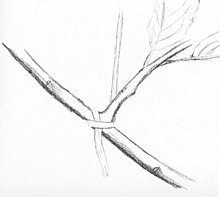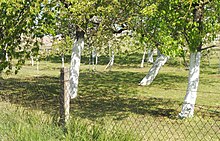Fruit tree
Fruit trees are trees that bear fruit - mainly raw, edible fruit .
use
Fruit trees are usually grown systematically and can then be found in gardens or plantations . Traditional forms of fruit growing were the orchard, later often called the orchard meadow , the fruit avenue and the orchard .
The typical expansion forms of the fruit trees ( espalier , spindle bush, half and high trunk) are created through a combination of plant refinement and pruning of the plants. The natural form, i.e. not cultivated by selection , unrefined and uncut form would usually have a lower, but especially irregular yield and an unpredictable taste and unpredictable quality of the fruit.
Typical fruit trees are the rose family trees ( pome fruit : cultivated apple , cultivated pear , quince ; stone fruit : cherry tree ), almond tree (also a stone fruit), walnut tree , in the broader sense of the nut fruit also pistachio , sweet chestnut , some olive trees (such as the olive tree ), the citrus fruits , or palms ( date , which is also a nut fruit), and tree-like representatives of many other plant families with different shapes of the fruits.
The spindle bushes are now very widespread , in which well-known table types are refined on weakly growing substrates so that a relatively low final height of up to about 3 m is not exceeded.
Some fruit trees do not bear fruit on steep branches. To remedy this, these branches can be tied down so that they form an angle of 45 ° or less to the ground.
Diseases
Recently, fire blight has had serious effects on fruit trees . It leads to larger felling actions, including the ecologically valuable standard trees.
Ecological function
Standard fruit trees are ecologically very valuable because they provide a habitat for many species of birds . But they are becoming increasingly rare, as their management is not so efficient (see under high trunk ). The Mundraub project maps fruit trees in Germany in order to preserve them as part of the cultural landscape .
planting
If the pH of the soil is below the optimal value of 6 to 6.5 for most fruit trees, lime should be added, ideally carbonate of magnesium lime. The pH value can be determined by a soil analysis. Local horticultural associations may be able to provide information on soil conditions. Clayey and stony soils should be thoroughly loosened. If cohesive soils are not loosened deep enough, the roots can suffer from waterlogging . From 30 to 40 cm depth of particularly high facilitated grave spade or semicircular of two spade hingedly joined hole sponsors , who also hand excavators or Erdlochausheber is called the lifting of the planting hole.
Sandy soil can be enriched with humus or bentonite . No fertilizer or manure should be added to the soil in the immediate vicinity of the roots. Rock flour is harmless. Compost must already have rotted well.
The shoots of the tree should be pruned by at least a third when transplanting in order to adapt the evaporation via the leaves to the roots damaged during excavation. The cut is made just above the buds. The roots should be kept moist and placed in water for up to a day before planting.
The planting should take place in frost-free weather. For better growth, the roots of the planted tree should be surrounded by loosened soil at least 30 cm in each direction. When filling the earth, no cavities should be left behind. The horizontal and vertical shaking of the tree when filling it in and treading it down allows the potting soil to slide down. The refining point must be a few centimeters above the surface of the soil. A slightly raised watering rim can be placed around the tree grate to make watering easier. Immediately next to the trunk, a support post is driven in that extends to the crown. The post is connected to the trunk with a soft band so that the tree cannot move even in strong winds.
The planting hole can be laid out with wire mesh against voles and the tree grate can be covered.
maintenance
After planting, the trunk should be protected from game bites and direct sunlight with bast, straw, jute fabric or perforated trunk protection sleeves. In winter, the warming of the cold trunk by the sun can otherwise cause the bark to tear.
In the third year, the bark can alternatively be protected by a lime coating , which is painted on in autumn until the crown is set. Ready-made mixtures are often expensive. Slaked lime is mixed with ten parts of water. The addition of horn meal can improve workability and strength. The mixture should swell for a while and be applied several times with the brush. Before application, the bark should be cleaned with a brush.
The tree grate should be kept free of vegetation in a size corresponding to the crown diameter and, if necessary, covered with mulch or a mulch disc made of plastic or coconut fiber . This prevents weeds, reduces evaporation from the soil, provides shelter for useful animals and provides long-term nutrients. The top layer can occasionally be loosened up with a lawn raker or long-stemmed onion planter.
cut
With the tree pruning in summer you can calm the growth and with a cut in winter you can promote growth, because the winter pruning supports the fertility and health of the tree. So that the shoots of the tree are not weakened by the cut, the wound must be able to heal. Tree pruning should not be carried out when the outside temperature is below 5 degrees.
fertilization
In order to achieve a permanent harvest, fruit trees should be fertilized about every two years at the beginning of the year in spring.
Are well suited
- rotten, deposited manure, especially from horses, cattle or sheep (fresh manure promotes shoot growth at the expense of fruit formation and increases the susceptibility of the plants)
- rotted, ripe compost mixed with organic nitrogen fertilizer , rock flour , algae lime or wood ash
- organic universal or wood fertilizer.
Compost should be mixed with nitrogen fertilizer before spreading. When using horn meal or horn shavings, stone fruit can receive around 100–140 g per tree and pome fruit 70–100 g. Rock flour or algae lime contain various minerals . Wood ash contains potassium in the form of potash .
Every four to five years, a soil analysis can provide information about the pH value and nutrient content of the soil in the area of the tree grate so that the fertilization can be adjusted accordingly.
See also
Web links
- A garden full of trees. Research project on the economic benefits of ecologically valuable fruit trees (Swiss research on agriculture, nutrition and the environment).
Individual evidence
- ↑ a b c d e planting fruit trees ; In: Manufactum.de; accessed in March 2020
- ^ Sour cherry, Prunus cerasus - plants, care & cutting , In: Gartenlexikon.de
- ↑ www.garten.de: Fruit tree pruning: The right time , March 13, 2014.
- ↑ Fertilize fruit trees , In: Manufactum.de; accessed in March 2020


